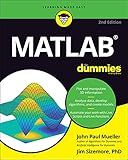Best MATLAB Guides to Buy in December 2025

Matlab Guide
- AFFORDABLE PRICES FOR QUALITY READS-SAVE MONEY ON GREAT BOOKS!
- ECO-FRIENDLY CHOICE: REUSE AND REDUCE WASTE WITH EVERY PURCHASE.
- UNIQUE SELECTIONS: DISCOVER RARE FINDS AND HIDDEN LITERARY GEMS.



MATLAB Guide, Third Edition



MATLAB Programming, For Beginners, Quick Start Guide: Matlab Language Crash Course Tutorial & Exercises (Paperbacks in 8 Hours)



A Guide to MATLAB



MATLAB: A Practical Introduction to Programming and Problem Solving



MATLAB Guide to Finite Elements: An Interactive Approach



MATLAB for Engineering Applications



MATLAB For Dummies



Engineers Guide to MATLAB, An


To create a big matrix in MATLAB, you can use several methods:
- Preallocating a matrix: One common approach is to preallocate a matrix and then assign values to its elements. This is generally faster than dynamically expanding the matrix. For example, to create a 1000x1000 matrix filled with zeros, you can use the following code: matrix = zeros(1000, 1000);
- Initializing with a specific value: You can also initialize a matrix with a specific value using the ones function or any other desired value. For instance, to create a 500x500 matrix with all elements equal to 5, you can write: matrix = 5 * ones(500, 500);
- Generating random values: MATLAB provides functions like rand and randn to create matrices filled with random values. For instance, to create a 200x200 matrix with random values between 0 and 1, you can use the following code: matrix = rand(200, 200);
- Combining existing matrices: MATLAB allows you to combine smaller matrices vertically or horizontally to form a larger matrix using functions like vertcat and horzcat. For example, to concatenate two 100x100 matrices horizontally, you can use the following code: matrix1 = rand(100, 100); matrix2 = rand(100, 100); matrix = horzcat(matrix1, matrix2);
These are just a few methods to create big matrices in MATLAB. Depending on your specific use case, you may adopt different approaches or use other MATLAB functions to manipulate and populate the matrix.
How to convert a matrix to a cell array in MATLAB?
To convert a matrix into a cell array in MATLAB, you can use the num2cell() function.
Here's an example:
% Example matrix matrix = [1 2 3; 4 5 6; 7 8 9];
% Convert matrix to cell array cellArray = num2cell(matrix);
% Display the converted cell array disp(cellArray);
Output:
[1] [2] [3] [4] [5] [6] [7] [8] [9]
In this example, the num2cell() function is used to convert each element of the matrix into separate cells in the cell array. The resulting cell array has the same dimensions as the original matrix.
How to calculate the determinant of a matrix in MATLAB?
In MATLAB, you can calculate the determinant of a matrix using the det() function. Here is the syntax:
D = det(A)
where A is the input matrix, and D is the resulting determinant value.
Here's an example:
A = [1 2 3; 4 5 6; 7 8 9]; D = det(A); disp(D);
Output:
0
Note that the input matrix must be square. If the input matrix is not square, MATLAB will return an error.
What is the difference between resizing and reshaping a matrix in MATLAB?
In MATLAB, resizing and reshaping a matrix are two different operations:
- Resizing: Resizing a matrix involves changing its dimensions (size) while keeping the same number of elements. This operation can either increase or decrease the size of the matrix. MATLAB provides the resize() function to resize a matrix. If the new size is larger than the original, the additional elements are filled with zeros. If the new size is smaller, the elements outside the new size are discarded.
- Reshaping: Reshaping a matrix involves changing its dimensions (size) by keeping the same number of elements but rearranging them in a different order. This operation does not change the actual values in the matrix but changes how they are organized. MATLAB provides the reshape() function to reshape a matrix. The new dimensions specified must have the same number of elements as the original matrix.
In summary, resizing a matrix changes its size while potentially adding or removing elements, while reshaping a matrix rearranges its existing elements in a different order while keeping the same number of elements.
How to declare a matrix in MATLAB?
In MATLAB, you can declare a matrix by using square brackets and separating the elements by commas or spaces. Here is the syntax to declare a matrix:
matrix = [element1, element2, ..., elementn]
You can also declare a matrix by placing each row as a separate row vector within square brackets. Each row vector is separated by a semicolon. Here is the syntax to declare a matrix using this method:
matrix = [row1; row2; ...; rowm]
For example, let's declare a 2x3 matrix:
matrix = [1, 2, 3; 4, 5, 6]
This will create a matrix with the following elements:
1 2 3 4 5 6
What is matrix rank in MATLAB?
In MATLAB, the matrix rank refers to the number of linearly independent rows or columns in a matrix. It can be computed using the "rank" function in MATLAB. The rank of a matrix provides information about the dimensionality and properties of the matrix, such as whether it is full rank, singular, or underdetermined. The rank function computes the numerical rank of a given matrix by calculating its singular values.
How to create a matrix with random values in MATLAB?
To create a matrix with random values in MATLAB, you can use the rand() or randn() functions.
- rand() function: Syntax: A = rand(m, n) m and n are the dimensions of the matrix (rows and columns, respectively). Example: A = rand(3, 4) creates a 3x4 matrix with random values between 0 and 1.
- randn() function: Syntax: A = randn(m, n) This function generates random values from a standard normal distribution (i.e., mean=0, standard deviation=1). Example: A = randn(2, 2) creates a 2x2 matrix with random values based on the standard normal distribution.
Alternatively, if you want to generate random integers within a specific range, you can use the randi() function:
- Syntax: A = randi([min_value, max_value], m, n)
- min_value and max_value define the range of random integers.
- Example: A = randi([1, 10], 3, 3) creates a 3x3 matrix with random integers between 1 and 10.
